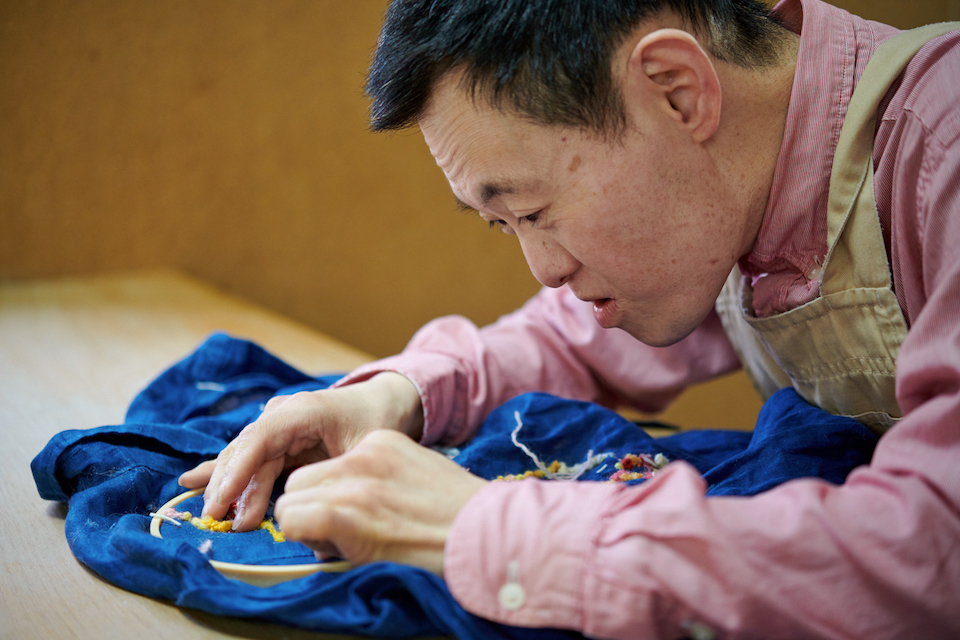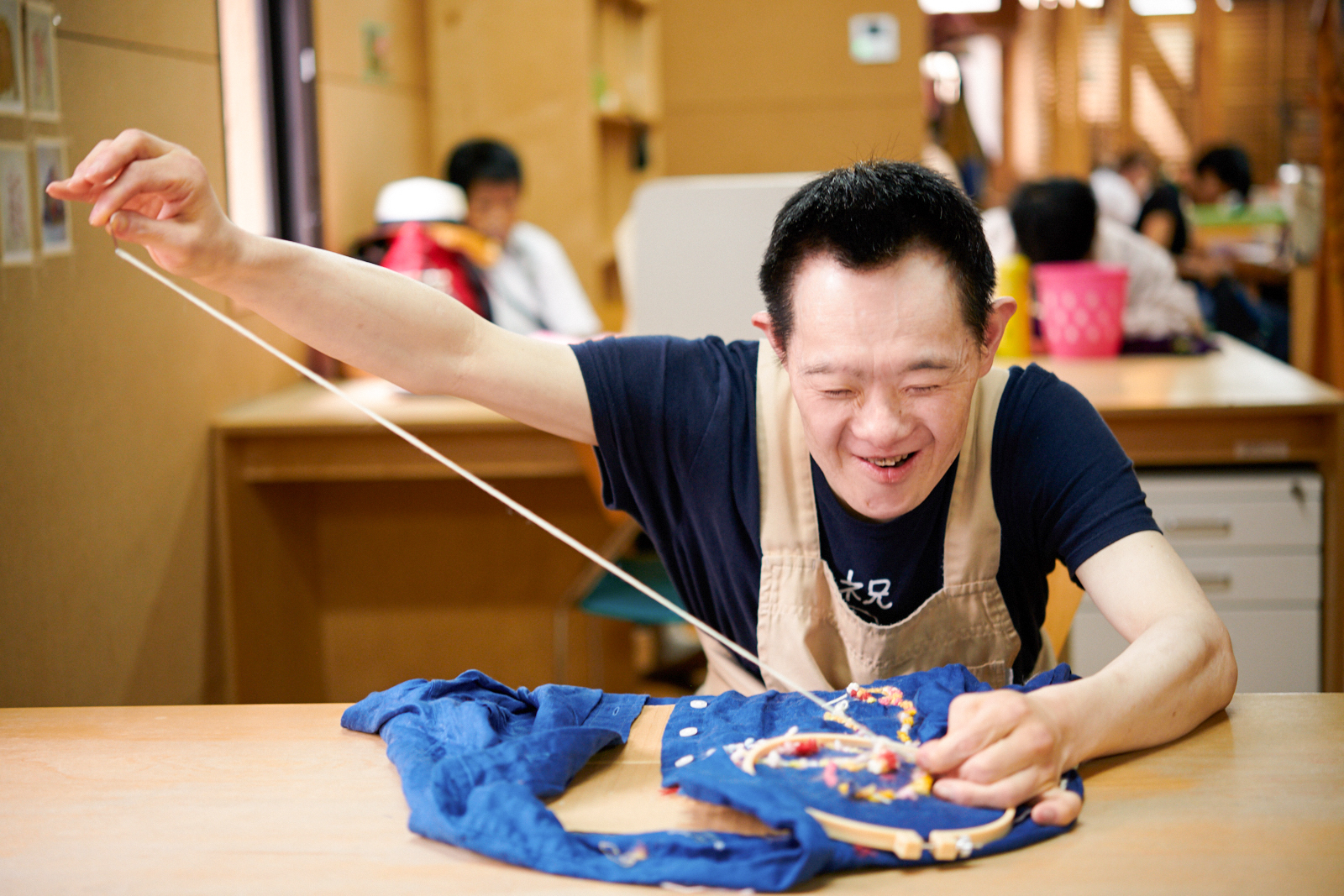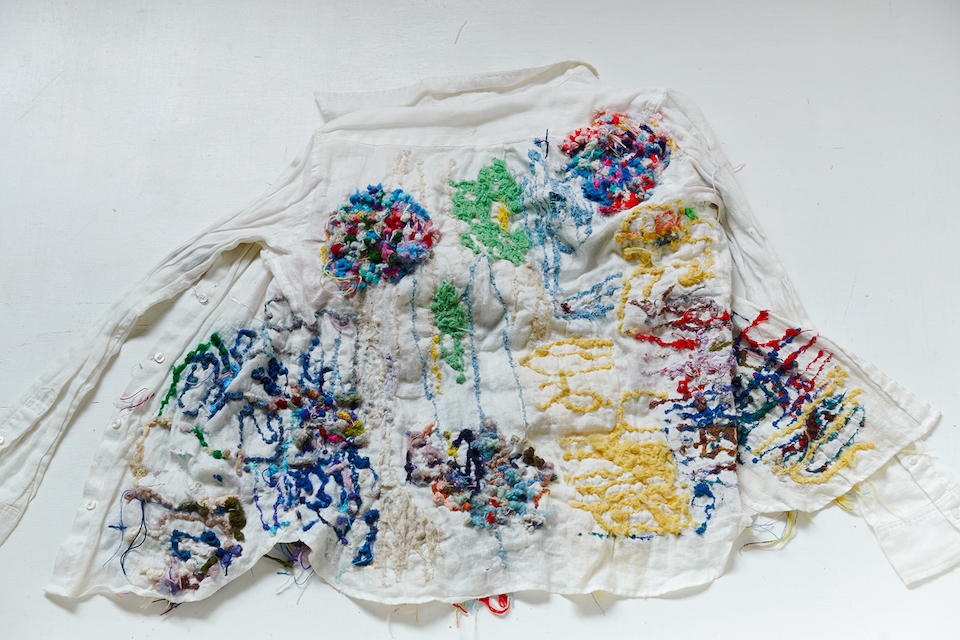He sews steadily, day after day, completing a shirt over the course of one to two years.
Right, left, right—Maeno swaps his needle from hand to hand. He pushes the needle through, then extends his right or left arm to its full length to pull the yarn taut in one direction or the other.
A member of the Textiles Workshop at Shobu Gakuen(Kagoshima Prefecture) since 1991, Maeno is a long-time participant in the nui project, where participants “work with a single needle, stitch after stitch,” using textiles as a means of self-expression allowing them to display their individuality. He has been creating works of embroidery for 28 years.

Maeno threads a needle with yarn.

Focusing to carefully push the needle through.

Maeno using an embroidery hoop for his work.
He sews steadily every day, but quite often he will be doing his ‘air embroidery,’” says JYŪRA Naoko, a member of staff at the Textile Workshop.
“Air embroidery” is the name that workshop staff have given to one of Maeno’s embroidery techniques. His embroidery is characterized by fuzzy, uneven yarn fibers, an effect created as he picks up previous stitches over and over again, building upward endlessly.
As described above, Maeno’s embroidery method involves swapping which hand he uses to hold his needle when pulling it up after making a stitch, extending his arms right, left, right as he sews. However, when we watched his work closely, we saw that the scooping motion of his needle was often too high, not touching the cloth or previously made stitches. When this happens, Maeno will continue the movement of his needle, unconcerned. “Air embroidery” perfectly describes his motions: he appears to be embroidering, without any physical results.
A selection of small bobbins of yarn in various colors, prepared by staff, is ready at his work table.
“He used to use fine silk thread like the thread used for Oshima pongee, but he switched to woolen yarn two or three years ago. Most of our participants like bright colors, but Tsutomu-san isn’t so picky about color. What he is concerned about is quantity. He seems to want to reassure himself by having a big stockpile of yarn, so if his supplies are running low, he’ll come to the staff and urge us to roll new bobbins for him. He’s unexpectedly stubborn and impatient, haha!”



As he picks up the top layer or yarn over and over again, Maeno’s works gain a fluffiness and three-dimensionality
Sticking to his own pace, standing by his own opinions. Only in an environment offering this choice could his works have emerged today.
So how does Maeno achieve his dense, raised embroidery style?
I asked FUKUMORI Noriko, founder of the nui project and Deputy General Manager of〈Shobu Gakuen〉.
“From when he first started, he’s always liked fine, softer yarns, but his first works were flatter. I think he maybe wasn’t sure how far he should go. It didn’t matter if we told him ‘take the yarn from here,’ or ‘this is how you unwind the yarn’—Tsutomu-san has a stubborn side, so he would cut the yarn halfway through, or take yarn from somewhere else and get all tangled up. At first the staff would warn him about it, but we gave up in the end and he kept on working like that, as he liked.
He kept going even when his yarn was all tangled up, and he seemed to be enjoying his ‘air embroidery,’ where the needle doesn’t go through, so we left him to it. And then it feels like his embroidery piled up and became three dimensional while we weren’t looking. We were surprised, too. From that moment on, instead of being critical, we understood that he was better able to create good pieces when he did things his own way, so we left him to work at his own pace, and here we are.”

《Untitled》; cotton organdy, cotton thread, silk thread /2002
This work, in which numerous nubs of thread have been embroidered on soft organdy, was created in 2002.
“At that time, we had some Oshima pongee silk thread left over from a previous subcontract, so he was working with that. Pongee silk thread is fine, but Tsutomu picked at it with the tip of his needle to make it really fuzzy. As he continued sewing over it, it became even fuzzier and developed a fluffiness and softness,” Fukumori recalls.
“He’s stubborn and sticks to his own pace, but he’s never refused to work on his embroidery. Because his movements are slow, I’ll think he isn’t making much progress, but if I look away for a moment, I’ll look back to find that he’s made a fairly big pile, so you could say that the work itself goes faster that I expect. Maybe it’s that when he’s embroidering, he’s embroidering, and when he’s doing his ‘air embroidery,’ he’s simply having fun.”

In this work, Maeno ended up sewing his wooden embroidery hoop to the piece as he embroidered in fine silk thread. He must have picked up the thread many times to create such a fluffy effect.

The front and back of the shirt have a completely different aspect. Tangles and cut yarn become a work of art themselves.


In the past, Maeno would spend around a year embroidering a single shirt, but in recent years has tended to continue his sewing work over a period of two to three years. When he begins to have difficulty in his movements or his hands still, staff judge that he has finished a piece and try passing him another piece of cloth. When Maeno accepts a new piece of cloth, his previous work is complete.
Maeno uses an embroidery hoop in his work, repeating a process of piling the frame high with yarn before moving on to the next area when he runs out of space. The positions of his hoop can be traced on the cloth, emerging like a pattern of flowers. While the neat globes materializing from the colorful yarn are beautiful, the form taken by the bunches of yarn revealed when we turn over the shirt, trailing down with their ends left long, has its own appeal, giving the startling impression of peeking into the inside of the body.
In the case of the black shirt pictured above, Maeno sewed his embroidery hoop to the cloth without noticing, and seems to have decided to present the work as is.

Maeno with staff member Jyūra.

Maeno selects and keeps a supply of yarn he likes, wound onto small bobbins by staff.
“Work starts in the studio at 9:30 every morning, but Tsutomu-san always goes at his own pace. He’ll take his time putting on his apron, going to the restroom, and so on, and come to the staff to get his needle and scissors at around 10:30, when everyone else has been working for a while. ‘Oh, you’re ready now, are you?’ we’ll tease him, and we’ll all laugh together.” Sticking to his own pace, with a gentle smile on his face, he pulls his yarn to the right, then to the left. Stitch by




He’s an old hand at threading the needle. As always, he continues his embroidery at his own pace.

















